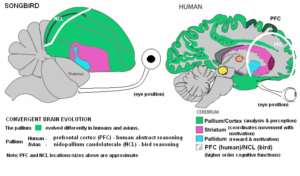Mapping the crow brain raises questions and possibilities.
The preceding “alien brain” article identified avian and human reasoning as processes occurring in the prefontal cortex (PFC) (human) and nidopallium caudolatarale (NCL) (avian).
Find the PFC and its avian counterpart, the NCL, in the generalized image below. (Hint: Press CTRL and + to enlarge page.)

These two homoplastic (i.e., similar in function, different in origin) reasoning areas of the human and avian brains have also been defined more generally, using different terminology. In the below instance, researchers at the University of Chicago were describing the differentiated areas with similar functions as neocortex (human) and dorsal ventricular ridge (DVR) (avian).
Clifton Ragsdale, Jennifer Dugas-Ford, and Joanna Rowell of U. Chicago studied chicken and zebra finches to find proof that the DVR has a lot in common with the neocortex. They were able to use molecular markers to identify the types of cells in the DVR, and found that the cells in a bird brain match two layers — the input and output neurons — of the neocortex.
Finding that different structures may have evolved to perform the same tasks will lead to many areas of research. Scientists will have new avenues to research cures for neurological damage related to paralysis, blindness, or other conditions. Learning the advantages and disadvantages of the varying structures may further help scientists understand how the brain performs the awesome processing that supports language, self-awareness, and intelligence.
You can read this brief article here.
The University of Chicago team found: “Both the DVR and the neocortex start their growth from the same place in the early embryonic stages of development.”
The above statement is very similar to the “alien” article above which states that both the prefrontal cortex and the nidopallium caudolaterale evolved from the pallium (millions of years ago, of course).
On the human side, the neocortex is made up of 4 lobes (frontal lobe, parietal lobe, occipital lobe, temporal lobe). The prefrontal cortex covers the front part of the frontal lobe.
On the avian side, it the nidopallium is within the dorsal ventricular ridge.
Therefore, the discussion of homologic function in different terms appears more reflective of different research approaches than of very different findings.
For an in-depth discussion of the homology of brain structure between mammals, birds, and reptiles, see this article.
Click next page to read an article by Viet, Hartman, and Nieder, which centers on working memory of crows.



